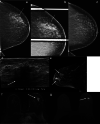Mimickers of breast malignancy: imaging findings, pathologic concordance and clinical management
- PMID: 33877461
- PMCID: PMC8058137
- DOI: 10.1186/s13244-021-00991-x
Mimickers of breast malignancy: imaging findings, pathologic concordance and clinical management
Abstract
Many benign breast entities have a clinical and imaging presentation that can mimic breast cancer. The purpose of this review is to illustrate the wide spectrum of imaging features that can be associated with benign breast diseases with an emphasis on the suspicious imaging findings associated with these benign conditions that can mimic cancer. As radiologic-pathologic correlation can be particularly challenging in these cases, the radiologist's familiarity with these benign entities and their imaging features is essential to ensure that a benign pathology result is accepted as concordant when appropriate and that a suitable management plan is formulated.
Keywords: Benign breast disease; Benign breast masses; Breast cancer; Inflammatory breast disease; Radiologic-pathologic concordance.
Conflict of interest statement
The authors declare that they have no competing interests.
Figures















Similar articles
-
Radiologic-Pathologic Correlation for Benign Results After MRI-Guided Breast Biopsy.AJR Am J Roentgenol. 2017 Aug;209(2):442-453. doi: 10.2214/AJR.16.17048. Epub 2017 May 24. AJR Am J Roentgenol. 2017. PMID: 28537753 Review.
-
Mimickers of breast malignancy on breast sonography.J Ultrasound Med. 2013 Nov;32(11):2029-36. doi: 10.7863/ultra.32.11.2029. J Ultrasound Med. 2013. PMID: 24154908 Review.
-
The value of 6-month interval imaging after benign radiologic-pathologic concordant minimally invasive breast biopsy.Ann Surg Oncol. 2013 Oct;20(10):3163-8. doi: 10.1245/s10434-013-3114-3. Epub 2013 Aug 22. Ann Surg Oncol. 2013. PMID: 23975288
-
Demystifying Breast Disease Markers.Radiographics. 2023 Oct;43(10):e220151. doi: 10.1148/rg.220151. Radiographics. 2023. PMID: 37676826
-
Improving Patient Care by Incorporation of Multidisciplinary Breast Radiology-Pathology Correlation Conference.Can Assoc Radiol J. 2016 May;67(2):122-9. doi: 10.1016/j.carj.2015.07.003. Epub 2015 Nov 26. Can Assoc Radiol J. 2016. PMID: 26632099
Cited by
-
Giant Infarcted Lactating Adenoma Mimicking Inflammatory Breast Carcinoma: A First Case Report from Somalia.Int Med Case Rep J. 2025 Jul 26;18:931-936. doi: 10.2147/IMCRJ.S528825. eCollection 2025. Int Med Case Rep J. 2025. PMID: 40740980 Free PMC article.
-
A Comprehensive Review of Breast Fibroadenoma: Correlating Clinical and Pathological Findings.Cureus. 2023 Dec 5;15(12):e49948. doi: 10.7759/cureus.49948. eCollection 2023 Dec. Cureus. 2023. PMID: 38179396 Free PMC article. Review.
-
Reducing Unnecessary Biopsies Using Digital Breast Tomosynthesis and Ultrasound in Dense and Nondense Breasts.Curr Oncol. 2022 Aug 4;29(8):5508-5516. doi: 10.3390/curroncol29080435. Curr Oncol. 2022. PMID: 36005173 Free PMC article.
-
Radiological Features of Male Breast Neoplasms: How to Improve the Management of a Rare Disease.Diagnostics (Basel). 2024 Jan 3;14(1):104. doi: 10.3390/diagnostics14010104. Diagnostics (Basel). 2024. PMID: 38201413 Free PMC article.
-
Biochemical "decoding" of breast ultrasound images with optoacoustic tomography fusion: First-in-human display of lipid and collagen signals on breast ultrasound.Photoacoustics. 2022 Jun 15;27:100377. doi: 10.1016/j.pacs.2022.100377. eCollection 2022 Sep. Photoacoustics. 2022. PMID: 35769886 Free PMC article.
References
-
- Sabaté JM, Clotet M, Gómez A, De Las HP, Torrubia S, Salinas T. Radiologic evaluation of uncommon inflammatory and reactive breast disorders. Radiographics. 2005;25(2):411–424. - PubMed
-
- Trop I, Dugas A, David J, et al. Breast abscesses: evidence-based algorithms for diagnosis, management, and follow-up. Radiographics. 2011;31(6):1683–1699. - PubMed
-
- Schäfer P, Fürrer C, Mermillod B. An association of cigarette smoking with recurrent subareolar breast abscess. Int J Epidemiol. 1988;17(4):810–813. - PubMed
-
- Rizzo M, Gabram S, Staley C, et al. Management of breast abscesses in nonlactating women. Am Surg. 2010;76(3):292–295. - PubMed
-
- Berna-Serna JD, Madrigal M. Percutaneous management of breast abscesses. An experience of 39 cases. Ultrasound Med Biol. 2004;30(1):1–6. - PubMed
Publication types
LinkOut - more resources
Full Text Sources
Other Literature Sources
Research Materials

